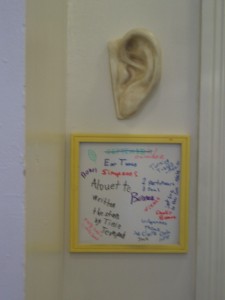Why is a big ear hanging on our wall in the studio? This reproduction of Michaelangelo’s David’s Ear sculpture is a fun way to bring focus to a favorite activity at LSMS – finding “ear tunes.” Ear Tunes is a term coined by us to represent a song that one has found strictly by ear – in other words trying various notes until your ear finds the right keys for a tune. Often students will bring in an ear tune of a song from the radio, a song from music class at school, or choir or church, or the ever popular Ode to Joy or Happy Birthday. We write them down on our Ear Tunes of the Week chart to give other students ideas for songs to try to find.
We actively encourage students to use their ears to find songs – Music is experienced and enjoyed with the ears. Therefore, the better your ears can discriminate the sounds the more rich your experience of music will be and the easier time you will have playing piano.
In the words of our mentor, Dr. Robert Pace, we want to develop “The ear that sees and the eye that hears.” That means, when you hear music, you form a mental image of the notes going up or down, and when you see printed music, you can hear the music playing in your head..
Some people naturally begin with an ability to play by ear well. Others may have a good relative sense of some notes’ relation to others. We find our students can improve this skill to a large extent through practice.
How do we develop this? We begin on a simple concept. Beginning with a 3 note range (we use 3 triplet black keys) –we develop the ability to hear whether the notes go up, down or repeat. Once this is secure, we add discriminating between a step (an adjacent key) or a skip (skipping over one key, making a larger interval between the first and second.) Once success within a 3 note range is achieved, this can be expanded to 5 finger positions (a range of five notes, and then to an 8 note scale.)
Some songs are easier because the intervals are smaller, and they stay within the 8 notes of the scale.
Others meander more and are more difficult.
Here are some “ear tunes” to try, to begin developing your ear.
3 note range (use three triplet notes or CDE)
Mary Had a little lamb on CDE *Hint – it starts by going down , not up (so play EDC or High Middle Low first)
Hot Cross Buns (also begins going down)
5 note range (CDEFG)
Ode to Joy (begin on E)
Alouette
6 note range
Twinkle Twinkle
Frere Jacques
Pentatonic (black keys only)
Amazing grace
Old MacDonald
Those Were the Days (from All in the Family, by Charles Strouse)
The Farmer in the Dell
Other popular starter ear tunes
Lean on Me
Happy Birthday
If you insist on beginning with Take Me out to the Ballgame or Star Spangled Banner
remember, you were warned, some songs are more complicated.

